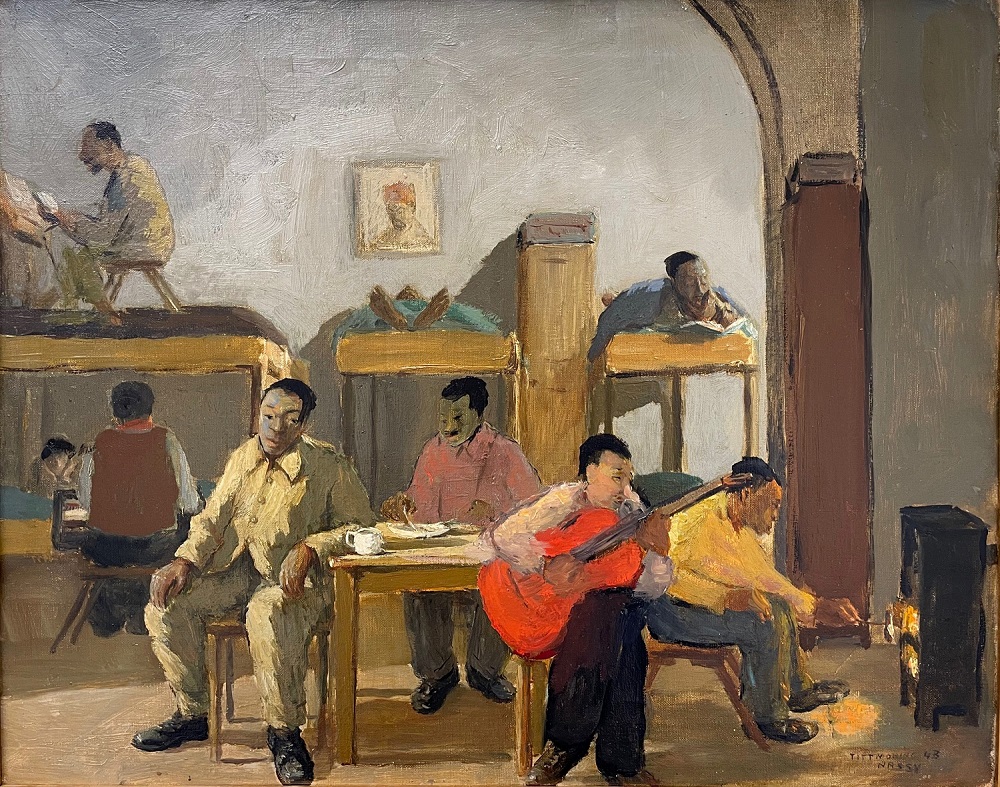Physical and Social Spaces of Exclusion: Nazi Germany and the Great Plains

Tittmoning 1943, by Josef Nassy. Collection of the USHMM.
A Regional Partnership co-organized with the Jack, Joseph and Morton Mandel Center for Advanced Holocaust Studies at the US Holocaust Memorial Museum and the Sam and Frances Fried Holocaust and Genocide Academy
Sam And Frances Fried Holocaust and Genocide Academy And Ushmm Regional Program Description
While vastly different in many respects, the history of Nazi Germany and the Great Plains included overlapping experiences such as the efforts at nation building, displacement and deportation, othering, exclusion, intergenerational trauma, intersecting victim’s voices, resiliency, and rebuilding.
This programming paid special attention to Native American history, Japanese incarceration, the great migration north and the reception of African Americans, as well as the persecution of people with disabilities and members of the LGBTQ community. Topics directly related to similar persecution experiences in the Holocaust such as the ghettoization of Jews, Sinti, and Roma, the forced displacement of victims of National Socialism, the murder of people with disabilities, Sinti-Roma, Jews, Afro-Germans, and gays, and the long-term impacts of mass murder.
Although different in many ways, the history of racism in Nazi Germany and the Plains region of the United States illuminates some universal phenomena that manifested in distinct historic persecution of individuals considered “others” in society. This initiative includes Iowa, Kansas, Manitoba, Minnesota, Nebraska, North and South Dakota, Oklahoma, and Saskatchewan.
Co-organized with the Jack, Joseph and Morton Mandel Center for Advanced Holocaust Studies at the US Holocaust Memorial Museum and the Sam and Frances Fried Holocaust and Genocide Academy, this regional program brought together scholars, students, and community members to engage in meaningful dialogue on how, when, and why governments and ordinary people supported, complied with, ignored, or resisted targeted oppression and racial violence in different historical contexts.
By exploring emerging research on the representation of historical persecution and violence, this initiative examined the lasting impact of racism for communities in different historical contexts.
Programming
Educator Workshop
In cooperation with UNO's Teacher Education/CEHHS and Department of History/Dual Enrollment.
Since 2016, the Academic Programs Division at the United States Holocaust Memorial Museum has engaged the Holocaust in conversation with North American persecution histories in ways that support, enrich, and improve teaching on both topics. Pedagogy roundtables are a critical part of this effort as we look to support practitioners in the classroom and to learn from one another. The history of the Holocaust can connect with many different topics and approaches that are often difficult for students to process and discuss in other contexts such as: how can we understand when and how persecution leads to genocide and when it does not? What is the role of the witness? What roles do individuals, institutions, and governments play? How do we engage in difficult subjects both sensitivity and with scholarly rigor? By thinking about and discussing our teaching, what has allowed for engaged conversations, and what has shut down discussions, we can learn from one another about how best to approach challenging topics in the future even when students are uncomfortable talking about them.
Speakers: Simone Schweber, Goodman Professor of Education and Jewish Studies, University of Wisconsin-Madison; Alecia Danielle Anderson, Associate Professor of Sociology and Anthropology, University of Nebraska at Omaha; Susana Grajales Geliga, Charles W. and Mary C. Martin Professor of Western American History, University of Nebraska at Omaha; Andrew J. Hogan, Henry W. Casper Professor of History, Departments of History and Medical Humanities, Creighton University. Moderator: Kierra Crago-Schneider, The Campus Outreach Program Officer University Programs, Jack, Joseph and Morton Mandel Center for Advanced Holocaust Research, United States Holocaust Memorial Museum.
Lunch 'N Learn for Graduate Students
Careers outside of academia led by led by Dr. Kierra Crago-Schneider, The Campus Outreach Program Officer University Programs, Jack, Joseph and Morton Mandel Center for Advanced Holocaust Research, United States Holocaust Memorial Museum. Topics included: which careers are available outside of academia? How do you become a public historian? How can you best market your skills gained at UNO for a career outside of academia? How can you best prepare your portfolio for a career outside of academia? How does one best network?
Joseph and Rebecca Meyerhoff Annual LectureIn cooperation with UNO's Department of History.
Title: Preserving Shared History: Art in Internment During the Holocaust
The Nazi party introduced antisemitic exclusionary laws shortly after Adolf Hitler was appointed German Chancellor in January 1933. While Jews were the primary target of persecution and murder, those who did not fit the “Aryan” ideal espoused by the Nazis were also persecuted under exclusionary regulations, including gay men, Black people, and Sinti and Roma in Germany. The Meyerhoff Annual Lecture explored work produced by Jewish and Black artists interned during the Holocaust and World War II. Paying special attention to Friedl Dicker-Brandeis’s work with children in the Theresienstadt Ghetto and Josef Nassy’s visual diary of his life in the Laufen and Tittmoning internment camps for enemy aliens, speakers discussed the importance of art in documenting persecution and murder while bearing witness to the atrocities and preserving the stories of those who endured the Holocaust–including the stories of victim groups othered in society. They also analyzed how, in some cases, creating art in internment was therapeutic and empowering, acted as a form of “spiritual resistance,” and served as a means of preserving a sense of normalcy or connection with a prewar past.
Speakers: Sarah Phillips Casteel, Professor, Department of English Language and Literature, Carleton University; Elizabeth Otto, Professor of Modern and Contemporary Art History, University at Buffalo. Moderator: Danielle Battisti, Department Chair, Associate Professor of History, University of Nebraska at Omaha.